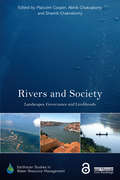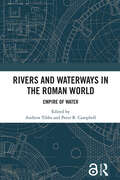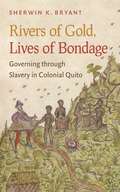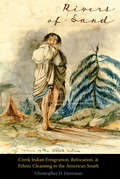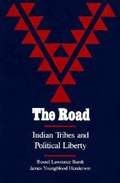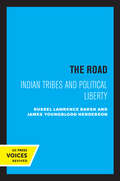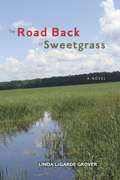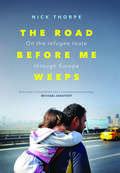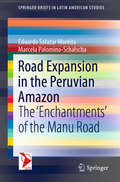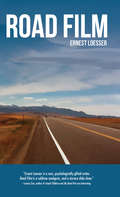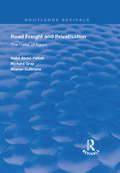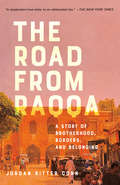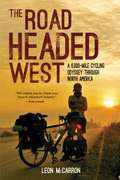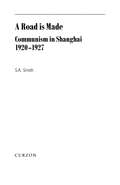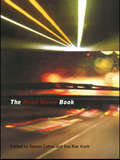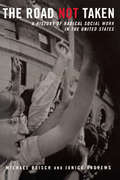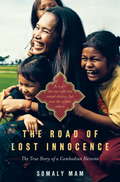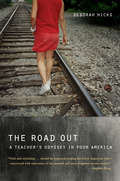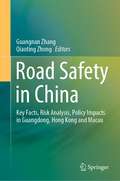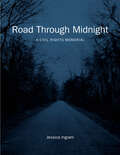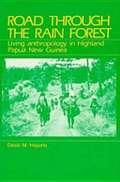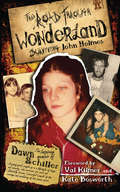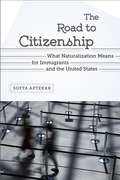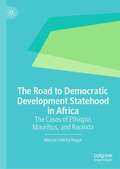- Table View
- List View
Rivers and Society: Landscapes, Governance and Livelihoods (Earthscan Studies in Water Resource Management)
by Malcolm Cooper Abhik Chakraborty Shamik ChakrabortyRivers and their watersheds constitute some of the most dynamic and complex landscapes. Rivers have sustained human communities, and human societies have utilized and altered river flows in a number of ways for millennia. However, the level of human impact on rivers, and on watershed environments, has become acute during the last hundred years or so. This book brings together empirical research and theoretical perspectives on the changing conditions of a range of river basin environments in the contemporary world, including the history and culture of local societies living in these river basins. It provides theoretical insights on the patterns and nature of the interaction between rivers and their use by human communities. The chapters are written from a variety of positions, including environmental science, hydrology, human ecology, urban studies, water management, historical geography, cultural anthropology and tourism studies. The case studies span different geographical regions, providing valuable insight on the multifaceted interactions between rivers and our societies, and on the changing riverscapes in different parts of the world. Specific detailed examples are included from Australia, Brazil, France, India, Iran, Japan, the Netherlands, New Zealand, South Africa, UK and USA.
Rivers and Waterways in the Roman World: Empire of Water
by Andrew Tibbs Peter B. CampbellTaking a broad geographical, temporal, and cross-disciplinary approach, this volume explores new and innovative research which focuses on rivers and waterways from across the Roman world. Rivers and Waterways in the Roman World brings together cross-disciplinary chapters focussing on theoretical approaches, new digital and scientific methods and analytical techniques, and related surveying and excavation case studies to examine the Romans extensive use of rivers and inland waterways around the Empire. Roman seafaring is well studied but this book expands our knowledge of Roman transport, communication and trade networks inland. The book highlights the challenges of archaeological work in the dynamic environments of rivers and waterways and showcases the use of new methodologies, including the increasing availability and accessibility of digital technologies that have led to a growth in the development and application of new archaeological and analytical techniques, as well as the discovery of new archaeological sites, many of which were previously inaccessible. This book is for archaeologists, historians, classicists, and geographers with an interest in the history and archaeology of the Roman Empire.
Rivers and Waterways in the Roman World: Empire of Water
by Andrew Tibbs Peter B. CampbellTaking a broad geographical, temporal, and cross-disciplinary approach, this volume explores new and innovative research which focuses on rivers and waterways from across the Roman world.Rivers and Waterways in the Roman World brings together cross-disciplinary chapters focussing on theoretical approaches, new digital and scientific methods and analytical techniques, and related surveying and excavation case studies to examine the Romans' extensive use of rivers and inland waterways around the Empire. Roman seafaring is well studied, but this book expands our knowledge of Roman transport, communication, and trade networks inland. The book highlights the challenges of archaeological work in the dynamic environments of rivers and waterways and showcases the use of new methodologies, including the increasing availability and accessibility of digital technologies that have led to a growth in the development and application of new archaeological and analytical techniques, as well as the discovery of new archaeological sites, many of which were previously inaccessible.This book is for archaeologists, historians, classicists, and geographers with an interest in the history and archaeology of the Roman Empire.Chapter 15 of this book is freely available as a downloadable Open Access PDF at http://www.taylorfrancis.com under a Creative Commons Attribution-Non Commercial-No Derivatives (CC-BY-NC-ND) 4.0 license.
Rivers of Gold, Lives of Bondage
by Sherwin K. BryantIn this pioneering study of slavery in colonial Ecuador and southern Colombia--Spain's Kingdom of Quito--Sherwin Bryant argues that the most fundamental dimension of slavery was governance and the extension of imperial power. Bryant shows that enslaved black captives were foundational to sixteenth-century royal claims on the Americas and elemental to the process of Spanish colonization. Following enslaved Africans from their arrival at the Caribbean port of Cartagena through their journey to Quito, Bryant explores how they lived during their captivity, formed kinships and communal affinities, and pressed for justice within a slave-based Catholic sovereign community.In Cartagena, officials branded African captives with the royal insignia and gave them a Catholic baptism, marking slaves as projections of royal authority and majesty. By licensing and governing Quito's slave trade, the crown claimed sovereignty over slavery, new territories, natural resources, and markets. By adjudicating slavery, royal authorities claimed to govern not only slaves but other colonial subjects as well. Expanding the diaspora paradigm beyond the Atlantic, Bryant's history of the Afro-Andes in the early modern world suggests new answers to the question, what is a slave?
Rivers of Sand: Creek Indian Emigration, Relocation, and Ethnic Cleansing in the American South (Indians of the Southeast)
by Christopher D. HavemanAt its height the Creek Nation comprised a collection of multiethnic towns and villages stretching across large parts of Alabama, Georgia, and Florida. By the 1830s, however, the Creeks had lost almost all this territory through treaties and by the unchecked intrusion of white settlers who illegally expropriated Native soil. With the Jackson administration unwilling to aid the Creeks in removing the squatters, the Creek people suffered from dispossession, starvation, and indebtedness. Between the 1825 Treaty of Indian Springs and the forced migrations beginning in 1836, nearly twenty-three thousand Creek Indians were relocated—voluntarily or involuntarily—to Indian Territory. Rivers of Sand fills a substantial gap in scholarship by capturing, for the first time, the full breadth and depth of the Creeks’ collective tragedy during the marches westward, on the Creek home front, and during the first years of resettlement. Unlike the Cherokee Trail of Tears, which was conducted largely at the end of a bayonet, most Creeks were removed through a combination of coercion and negotiation. Hopelessly outnumbered military personnel were forced to make concessions in order to gain the compliance of the headmen and their people. Christopher D. Haveman’s meticulous study uses previously unexamined documents to weave narratives of resistance and survival, making Rivers of Sand an essential addition to the ethnohistory of American Indian removal.
The Road: Indian Tribes and Political Liberty
by Russel Lawrence Barsh James Youngblood HendersonA book about the rights of Indian tribes on reservations within the United States. The political relationship between these tribes, the states in which they are located, and the federal government has long intrigued and perplexed Americans.
The Road: Indian Tribes and Political Liberty
by Russell Lawrence Barsh James Youngblood HendersonThis title is part of UC Press's Voices Revived program, which commemorates University of California Press’s mission to seek out and cultivate the brightest minds and give them voice, reach, and impact. Drawing on a backlist dating to 1893, Voices Revived makes high-quality, peer-reviewed scholarship accessible once again using print-on-demand technology. This title was originally published in 1980.
The Road Back to Sweetgrass: A Novel
by Linda Legarde GroverSet in northern Minnesota, The Road Back to Sweetgrass follows Dale Ann, Theresa, and Margie, a trio of American Indian women, from the 1970s to the present, observing their coming of age and the intersection of their lives as they navigate love, economic hardship, loss, and changing family dynamics on the fictional Mozhay Point reservation. As young women, all three leave their homes. Margie and Theresa go to Duluth for college and work; there Theresa gets to know a handsome Indian boy, Michael Washington, who invites her home to the Sweetgrass land allotment to meet his father, Zho Wash, who lives in the original allotment cabin. When Margie accompanies her, complicated relationships are set into motion, and tensions over "real Indian-ness" emerge. <P><P>Dale Ann, Margie, and Theresa find themselves pulled back again and again to the Sweetgrass allotment, a silent but ever-present entity in the book; sweetgrass itself is a plant used in the Ojibwe ceremonial odissimaa bag, containing a newborn baby's umbilical cord. In a powerful final chapter, Zho Wash tells the story of the first days of the allotment, when the Wazhushkag, or Muskrat, family became transformed into the Washingtons by the pen of a federal Indian agent. This sense of place and home is both tangible and spiritual, and Linda LeGarde Grover skillfully connects it with the experience of Native women who came of age during the days of the federal termination policy and the struggle for tribal self-determination. <P><P>The Road Back to Sweetgrass is a novel that that moves between past and present, the Native and the non-Native, history and myth, and tradition and survival, as the people of Mozhay Point navigate traumatic historical events and federal Indian policies while looking ahead to future generations and the continuation of the Anishinaabe people.
The Road Before Me Weeps: On the Refugee Route Through Europe
by Nick ThorpeA powerful and revealing firsthand account of the migrant and refugee experience on the overland route across Europe War and chaos in Syria and Iraq, violence in Afghanistan, and hopelessness in countries bordering war zones have spurred several million refugees and migrants to set out for Europe. The West Balkans, from Turkey through Greece, Macedonia, Bulgaria, Serbia, and Hungary, became the main entry route. Based in Budapest for more than three decades, Nick Thorpe was perfectly placed to cover the birth of the route, its heyday, and the attempts of numerous states to close it. This is his intimate account of the daily lives of those stuck in razor-wire enclosures or on the move along forest tracks, railway lines, motorways—and of the smugglers, border police, and political leaders who help, exploit, or obstruct them. He challenges those who demonize or glorify migration, visits the arrivals in their new environment, and studies their impact on the countries which welcomed them with open arms or hesitation.
Road Expansion in the Peruvian Amazon: The 'Enchantments' of the Manu Road (SpringerBriefs in Latin American Studies)
by Eduardo Salazar Moreira Marcela Palomino-SchalschaThis book provides in-depth insights into the construction of the first road to reach riparian communities and the main access point to a national park in the Amazonian rain forest. It is based on an ethnographic investigation in Peru’s Manu Province in the Amazon, which explored diverse local attitudes towards the construction of a road in the overlapping buffer zone of two protected areas: the Manu National Park and the Amarakaeri Communal Reserve. The book reveals the applicability of Harvey and Knox’s concept of ‘enchantments of infrastructure’ in the case of first roads, but also makes accessible wider debates in political ecology such as territoriality and frontier development. The promise of first roads sparks feelings of aspiration and anticipation of the advent of development through speedy travel, economic connectivity and political integration. Yet these developments seldom take shape as expected. The author explores the perspectives, social dynamics and political maneuvers that influence first road building processes in the Amazon, which have applicability to experiences and strategies of road development elsewhere.
Road Film
by Ernest LoesserFramed as a cinematic odyssey, Road Film owes its debt to the famous road movies from the 1960s-80s. Every reader rides shotgun on a trajectory into an American imagination full of joy and angst. Loesser's mix of prose and verse displays the best of the tradition of the New Sentence-and his work as a journalist in New York as a young man, post 9/11. The result reassembles all the broken episodes collected along the lost highways of America: discarded and violent news reports, local and violent rumors, and the unverifiable stories passed from one traveler to the next.Much like his previous work, Touched by Lightning, Loesser uses a reportorial instinct to transfigure the recurrent patterns he finds as a poet in the isolated corners of our homeland. Throughout Road Film, the driver races between two coasts; he jumps from the city into the wilderness-always skirting the moribund American suburbs, and though there be familiar faces, the author's route never leads toward that simple place called home.
Road Freight and Privatisation: The Case of Egypt (Routledge Revivals)
by Nabil Abdel-Fattah Richard Gray Sharon CullinaneFirst published in 1999, this volume forms part of the Plymouth Studies in Contemporary Shipping series and focuses on Egyptian road freight privatisation. The series represents a unique collection of papers and edited texts from the leading maritime institute in Western Europe at the University of Plymouth. It covers all aspects of the industry from operations through to the logistical framework that supports the sector. Designed both for practising academics and the shipping and ports industry itself, the series, combining the output from some of the leading academic commentators in the world from the UK, Korea, Germany and Poland, is an original and novel contribution to the maritime debate.
The Road from Raqqa: A Story of Brotherhood, Borders, and Belonging
by Jordan Ritter ConnCrossing years and continents, the harrowing story of the road to reunion for two Syrian brothers who—despite a homeland at war and an ocean between them—hold fast to the bonds of family. <P><P>“The Road from Raqqa had me gripped from the first page. I couldn&’t put it down.”—Christy Lefteri, author of The Beekeeper of Aleppo <P><P>The Alkasem brothers, Riyad and Bashar, spend their childhood in Raqqa, the Syrian city that would later become the capital of ISIS. As a teenager in the 1980s, Riyad witnesses the devastating aftermath of the Hama massacre—an atrocity that the Hafez al-Assad regime commits upon its people. <P><P>Wanting to expand his notion of government and justice, Riyad moves to the United States to study law, but his plans are derailed and he eventually falls in love with a Southern belle. They move to a suburb of Nashville, Tennessee, where they raise two sons and where Riyad opens a restaurant—Café Rakka—cooking the food his grandmother used to make. But he finds himself confronted with the darker side of American freedoms: the hardscrabble life of a newly arrived immigrant, enduring bigotry, poverty, and loneliness. Years pass, and at the height of Syria&’s civil war, fearing for his family’s safety halfway across the world, he risks his own life by making a dangerous trip back to Raqqa. <P><P>Bashar, meanwhile, in Syria. After his older brother moves to America, Bashar embarks on a brilliant legal career under the same corrupt Assad government that Riyad despises. Reluctant to abandon his comfortable (albeit conflicted) life, he fails to perceive the threat of ISIS until it’s nearly too late.The Road from Raqqa brings us into the lives of two brothers bound by their love for each other and for the war-ravaged city they call home. <P><P>It’s about a family caught in the middle of the most significant global events of the new millennium, America's fraught but hopeful relationship to its own immigrants, and the toll of dictatorship and war on everyday families. It’s a book that captures all the desperation, tenacity, and hope that come with the revelation that we can find home in one another when the lands of our forefathers fail us.
Road Headed West: A 6,000-Mile Cycling Odyssey through North America
by Leon MccarronWhat happens when you swap the nine-to-five for two wheels and a journey of a lifetime? Terrified of the prospect of a life spent behind a desk, without challenge or excitement, Leon takes off to cross America on an overloaded bicycle packed with everything but common sense. Over five months and 6000 miles, he cycled from New York to Seattle and then on to the Mexican border, facing tornados, swollen river crossings, wild roaming buffalo and one hungry black bear along the way. But he also met kind strangers, who offered their food, wisdom, hospitality and even the occasional local history lesson, and learned what happens when you take a chance and follow the scent of adventure. With a sharp eye and a genuine go-where-the-wind-takes-me attitude, McCarron makes for an ideal guide on this cycling adventure. He passes through small towns, rolls up and flies down the winding roads of the Blacks Hills is taken in and fed by strangers, all on a quest to discover the "real” America, and in the process, learn a little about himself. Funny, insightful, and full of life, The Road Headed West will inspire readers to chase their dreams and go off in search of adventure.
A Road Is Made: Communism in Shanghai 1920-1927 (Chinese Worlds)
by Steve SmithThis is a study of the activities, ideas and internal life of the Chinese Communist Party in Shanghai during its formative period. It investigates the party's relations to the city's students and teachers, women, entrepreneurs, secret societies and its workers, and examines the efforts to transform the CCP into a 'Leninist' party, exploring relations between intellectuals and workers, men and women, Chinese and Russians within the party. The book culminates in a detailed analysis of the three armed uprisings which led to the CCP's briefly taking power in March 1927, before being crushed by troops loyal to Chiang Kai-shek. The study highlights the extent to which the Soviet Union sought to manipulate China's national revolution, yet also reveals how divisions at every level of the Comintern allowed the CCP to achieve a degree of independence and to conduct policy at considerable variance with that laid down by Moscow.
The Road Movie Book
by Steven Cohan Ina Rae HarkThe Road Movie Book is the first comprehensive study of an enduring but ever-changing Hollywood genre, its place in American culture, and its legacy to world cinema. The road and the cinema both flourished in the twentieth century, as technological advances brought motion pictures to a mass audience and the mass produced automobile opened up the road to the ordinary American. When Jean Baudrillard equated modern American culture with 'space, speed, cinema, technology' he could just as easily have added that the road movie is its supreme emblem.The contributors explore how the road movie has confronted and represented issues of nationhood, sexuality, gender, class and race. They map the generic terrain of the road movie, trace its evolution on American television as well as on the big screen from the 1930s through the 1980s, and, finally, consider road movies that go off the road, departing from the US landscape or travelling on the margins of contemporary American culture.Movies discussed include:* Road classics such as It Happened One Night, The Grapes of Wrath, The Wizard of Oz and the Bob Hope-Bing Crosby Road to films* 1960's reworkings of the road movie in Easy Rider and Bonnie and Clyde* Russ Meyer's road movies: from Motorpsycho! to Faster Pussycat! Kill! Kill!* Contemporary hits such as Paris Texas, Rain Man, Natural Born Killers and Thelma and Louise* The road movie, Australian style, from Mad Max to the Adventures of Priscilla, Queen of the Desert.
The Road Not Taken: A History of Radical Social Work in the United States
by Michael Reisch Janice AndrewsThe Road Not Taken takes a new perspective on the course of social welfare policy in the twentieth century. This examination looks at the evolution of social work in the United States as a dynamic process not just driven by mainstream organizations and politics, but strongly influenced by the ideas and experiences of radical individuals and marginalized groups as well.
The Road of Lost Innocence: As a girl she was sold into sexual slavery, but now she rescues others. The story of a Cambodian heroine.
by Somaly MamA portion of the proceeds of this book will be donated to the Somaly Mam Foundation.A riveting, raw, and beautiful memoir of tragedy and hopeBorn in a village deep in the Cambodian forest, Somaly Mam was sold into sexual slavery by her grandfather when she was twelve years old. For the next decade she was shuttled through the brothels that make up the sprawling sex trade of Southeast Asia. Trapped in this dangerous and desperate world, she suffered the brutality and horrors of human trafficking--rape, torture, deprivation--until she managed to escape with the help of a French aid worker. Emboldened by her newfound freedom, education, and security, Somaly blossomed but remained haunted by the girls in the brothels she left behind.Written in exquisite, spare, unflinching prose, The Road of Lost Innocence recounts the experiences of her early life and tells the story of her awakening as an activist and her harrowing and brave fight against the powerful and corrupt forces that steal the lives of these girls. She has orchestrated raids on brothels and rescued sex workers, some as young as five and six; she has built shelters, started schools, and founded an organization that has so far saved more than four thousand women and children in Cambodia, Thailand, Vietnam, and Laos. Her memoir will leave you awestruck by her tenacity and courage and will renew your faith in the power of an individual to bring about change.To learn more about how you can help fight human trafficking, visit the foundation's website: www.somaly.org.
The Road Out
by Deborah HicksCan one teacher truly make a difference in her students' lives when everything is working against them? Can a love for literature and learning save the most vulnerable of youth from a life of poverty? The Road Out is a gripping account of one teacher's journey of hope and discovery with her students--girls growing up poor in a neighborhood that was once home to white Appalachian workers, and is now a ghetto. Deborah Hicks, set out to give one group of girls something she never had: a first-rate education, and a chance to live their dreams. A contemporary tragedy is brought to life as she leads us deep into the worlds of Adriana, Blair, Mariah, Elizabeth, Shannon, Jessica, and Alicia?seven girls coming of age in poverty. This is a moving story about girls who have lost their childhoods, but who face the street's torments with courage and resiliency. "I want out," says 10-year-old Blair, a tiny but tough girl who is extremely poor and yet deeply imaginative and precocious. Hicks tries to convey to her students a sense of the power of fiction and of sisterhood to get them through the toughest years of adolescence. But by the time they're sixteen, eight years after the start of the class, the girls are experiencing the collision of their youthful dreams with the pitfalls of growing up in chaotic single-parent families amid the deteriorating cityscape. Yet even as they face disappointments and sometimes despair, these girls cling to their desire for a better future. The author's own life story--from a poorly educated girl in a small mountain town to a Harvard-educated writer, teacher, and social advocate--infuses this chronicle with a message of hope.
Road Safety in China: Key Facts, Risk Analysis, Policy Impacts in Guangdong, Hong Kong and Macau
by Guangnan Zhang Qiaoting ZhongThis book presents comprehensive research and analyses on road traffic safety in China, discussing individual, vehicle, road and environmental factors to improve road safety in the country. It also sheds light on the development of similar (adjusted) measures to reduce traffic violations and/or accident fatalities and injuries, and to promote road safety in other countries and regions. As such, it is a valuable resource for anyone wanting to understand the characteristics and patterns of road traffic safety, the risk factors affecting traffic violations and traffic injuries, as well as road safety policies and practices in China.
Road Through Midnight: A Civil Rights Memorial (Documentary Arts and Culture, Published in association with the Center for Documentary Studies at Duke University)
by Jessica IngramAt first glance, Jessica Ingram's landscape photographs could have been made nearly anywhere in the American South: a fenced-in backyard, a dirt road lined by overgrowth, a field grooved with muddy tire prints. These seemingly ordinary places, however, were the sites of pivotal events during the civil rights era, though often there is not a plaque with dates and names to mark their importance. Many of these places are where the bodies of activists, mill workers, store owners, sharecroppers, children and teenagers were murdered or found, victims of racist violence. Images of these places are interspersed with oral histories from victims' families and investigative journalists, as well as pages from newspapers and FBI files and other ephemera.With Road Through Midnight, the result of nearly a decade of research and fieldwork, Ingram unlocks powerful and complex histories to reframe these commonplace landscapes as sites of both remembrance and resistance and transforms the way we regard both what has happened and what's happening now—as the fight for civil rights goes on and memorialization has become the literal subject of contested cultural and societal ground.
Road Through The Rain Forest: Living Anthropology In Highland Papua New Guinea
by David M. HayanoThis is Hayano's personal narrative of his fieldwork with the Awa, & how he seeks to understand both the Awa & himself in the process.
The Road Through Wonderland
by Kate Bosworth Dawn Schiller Val KilmerPainstakingly honest, this chilling memoir reveals how a teenager became immersed in the bizarre life of legendary porn star John Holmes. Starting with a childhood that molded her perfectly to fall for the seduction of "the king of porn," this autobiography recounts the perilous road that Dawn Schiller traveled-from drugs and addiction to beatings, arrests, forced prostitution, and being sold to the drug underworld. After living through the horrific Wonderland murders of 1981, she entered protective custody, ran from the FBI, and turned in John Holmes to the police. This is the true story of a young girl's harrowing escape from one of the most infamous public figures, her struggle to survive, and her recovery from unthinkable abuse.
The Road to Citizenship
by Sofya AptekarBetween 2000 and 2011, eight million immigrants became American citizens. In naturalization ceremonies large and small these new Americans pledged an oath of allegiance to the United States, gaining the right to vote, serve on juries, and hold political office; access to certain jobs; and the legal rights of full citizens. In The Road to Citizenship, Sofya Aptekar analyzes what the process of becoming a citizen means for these newly minted Americans and what it means for the United States as a whole. Examining the evolution of the discursive role of immigrants in American society from potential traitors to morally superior "supercitizens," Aptekar's in-depth research uncovers considerable contradictions with the way naturalization works today. Census data reveal that citizenship is distributed in ways that increasingly exacerbate existing class and racial inequalities, at the same time that immigrants' own understandings of naturalization defy accepted stories we tell about assimilation, citizenship, and becoming American. Aptekar contends that debates about immigration must be broadened beyond the current focus on borders and documentation to include larger questions about the definition of citizenship. Aptekar's work brings into sharp relief key questions about the overall system: does the current naturalization process accurately reflect our priorities as a nation and reflect the values we wish to instill in new residents and citizens? Should barriers to full membership in the American polity be lowered? What are the implications of keeping the process the same or changing it? Using archival research, interviews, analysis of census and survey data, and participant observation of citizenship ceremonies, The Road to Citizenship demonstrates the ways in which naturalization itself reflects the larger operations of social cohesion and democracy in America.
The Road to Democratic Development Statehood in Africa: The Cases of Ethiopia, Mauritius, and Rwanda
by Marcel Felicity NagarThis book interrogates Africa’s pursuit of the Democratic Developmental State model by drawing on the experiences of Mauritius, Ethiopia, and Rwanda. It comprises of five parts: Part I, consisting of two chapters, outlines the key conceptual and theoretical approaches used throughout the book’s discussions. The proceeding parts II, III and IV critically analyses the three case studies under review. Each part is subdivided into two chapters wherein a historical state-societal approach is employed in interrogating the extent to which Mauritius, Ethiopia, and Rwanda have been able to successfully achieve democratic development, on the one hand, and, conversely, inclusive economic growth and development, on the other. Part V, and Chapter 10 debuts the concept and model of the Developmental Civil Society.
